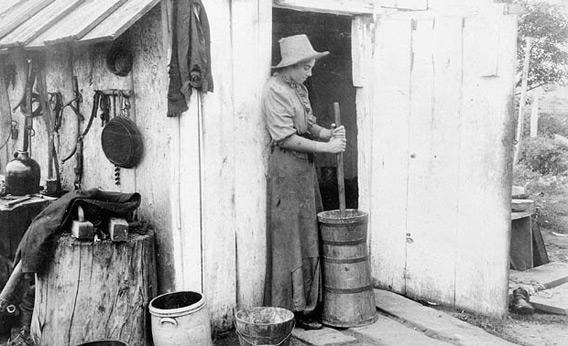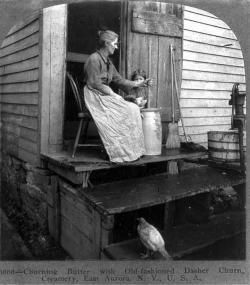
Photo by W. Braybrooke Bayley/Wikimedia Commons.
A few years ago, on a lark, I decided to make butter. This sounds like it might be some kind of arduous, gourmand pursuit, but it was quite simple. Following chef Daniel Patterson’s instructions, I bought a whole lot of cream and poured it into my trusty KitchenAid mixer, whose top I’d covered in plastic wrap to prevent splashing all over my kitchen. I turned the mixer on high. Ten or so minutes later, I had curds and real buttermilk. I separated the two in a sieve then squeezed the curds by hand to form a mass of butter. I rolled it out into a log and covered it in plastic. In a little more time than it takes to make eggs and toast, I’d made enough butter to last for weeks.
I never did it again. Sure, as Patterson had promised, my homemade butter was delicious, just about the best butter I’d ever tasted. (I am an expert on the taste of butter; ask my wife or my doctor.) But it was also extremely expensive—I’d spent nearly $10 in high-end cream to make about a pound of butter, which is about $4 more than I’d have spent to buy very nice butter made from the same fancy dairy that had produced my cream. For doing the work myself, I’d paid 67 percent more. And even if I’d bought cheaper cream, I couldn’t have come close to matching the price (not to mention the convenience) of store-bought butter. (Jennifer Reese comes to the same conclusion in Make the Bread, Buy the Butter, her awesome book about what you should and shouldn’t bother making at home.)
I got to thinking about my butter-making adventure when, as part of the Reader Takeover project, readers asked me to “review the most nontech gadgets you can think of—turn-of-the-century butter churns, cotton gins, trebuchets, etc!” (Thanks, you guys!) Let me start by confessing that I didn’t actually get hold of any of these things, so you will not hear me pass judgment on what features you should look for in a siege weapon this holiday season. I did, however, spend a lot of time researching and thinking about all of the energy and ingenuity humans have applied to the problem of making butter. As a result, I gained new respect both for butter (which I didn’t think possible) and for our ancestors, especially the women and children who spent many long hours every week turning cream into butter.
But the most interesting thing I discovered about churns was how little they, er, churned over the years. To someone used to the relentless pace of change in modern gadgetry, the difference between the earliest butter churns and the latest churns—by which I mean, the difference between how people made butter in the 1700s and how they made butter in the 1940s—seems hopelessly small. Butter is formed when the membranes surrounding fat globules in cream are stripped through the process of physical agitation; this allows the fat to clump together into a single mass, i.e., butter. Thus all churns work the same way—they transfer human power into physical agitation within a vessel holding cream—and that’s why they never really advanced until humans found a feasible alternative to human power. Until industrialization came along, all churning was the same: You spent minutes or hours plunging or cranking a shaft until, at some point you couldn’t quite predict, long after you felt your arms were about to fall off, butter began to form.

Keystone View Co./Library of Congress.
The slow pace of progress in churns was not for lack of trying. Because making butter was so arduous and time-consuming, it was an active area of commercial invention. According to the Encyclopedia of Kitchen History, inventors filed for 2,500 patents on better butter churns around the time of the Industrial Revolution. Doug & Linda’s Dairy Antique Site collects many of these patents and photos of churns over time. If you follow the timeline, you’ll notice lots of minor advances. For instance, before the mid-1800s or so, most people did not quite understand that the efficiency of churning depended on the temperature of the cream you were using; if the cream was too cold, butter wouldn’t form. The fact that you could sometimes churn and churn forever and still not see any butter sparked a great deal of superstition around butter-making. As Doug & Linda’s site explains:
Many times the cream would not form butter no matter how long one churned it. Many people felt that this was because the cream was haunted by a witch. Many people that churned butter believed in the “cream witch” and many churn advertisements referred to it. A couple of the remedies for a cream witch was to put a red hot horse shoe or a red hot poker into the cream. The cream would boil as the hot metal was put in the churn and people said this was the noise of the witch thrashing about as she was killed. In actuality the temperature of the cream was increased and often this was enough for the butter to start to form.
Around 1850, someone invented a “thermometer churn,” which featured two adjacent metallic chambers. You put your cream in one chamber, and in the second you added hot or cold water to raise or lower the cream’s temperature. (A thermometer mounted on the front let you know which to add.) Suddenly, thanks to a brilliant design change, the cream witch was dead.

Woman churning milk to butter, 1897.
Photo by J. W. Dunn/Library of Congress.
Other advances made churning more convenient. Some of the earliest churns were big, wooden monstrosities that required a great deal of physical force to operate. These produced many gallons of butter, which was ideal for people who lived on farms, but didn’t work for housewives in cities. In the early 1900s, something like what’s happening in the tech industry today began to hit the churn business—churns became smaller and more mobile. The Steve Jobs of the butter churn business was Nathan Dazey, whose firm, the Dazey Churn & Manufacturing Company, produced small, beautiful churns made of glass. Like Apple gadgets, Dazey churns (which have since become cherished collector’s items) weren’t cheap. In the 1920s a 2-quart Dazey churn sold for $2.30, which is about $27 in today’s dollars. Still, people loved them. According to Doug & Linda’s: “In the early 1920s Dazey claimed their factory was able to produce 2,000 butter churns a day. In 1915 Dazey claimed it had 250,000 butter churns in use, by 1923 they boasted of two million satisfied users and by 1936 the number increased to three million.”
Because glass churns contained only a small amount of cream, they made butter much faster than the bigger, older churns. (Of course, they made less butter, so you probably had to make butter more often—or, you know, switch to extra-virgin olive oil already.) In the 1920s, some churns even began to add gears into their handles in order to speed up the paddles which agitated the cream. This could make for very fast butter. One glass churn that hit the market then was called the Premier Two-Minute Butter Machine, and it was advertised to “positively make butter in two minutes and whip cream in one.”
This might sound like an advance to you: Compared to spending hours and hours turning a crank in the early 1800s, people in the 1920s could whip up some butter in a couple minutes’ time. The problem, of course, is that a 19th-century farm girl who spent half her week churning butter would have been long dead by the launch of the Two-Minute Butter Machine. For her, churning was hopelessly static—not only did churns never change, but she’d have been crazy to imagine that anyone would ever make butter any differently. And her point of view would have been mostly correct. It took 100 years to get a slightly better churn (and really it was only better because it produced butter in smaller quantities).
This, I think, highlights the most remarkable fact about our current tech age: Whatever problem you have with your gadget today, you can always expect that something better will come along soon, probably even sooner than you think possible. Where people in butter-churn age would have been justified in thinking that their products would never improve, our default is to expect constant improvement. Indeed, in some corners of tech, improvement is so constant that it’s become nearly predictable—we know, for instance, that in 18 months’ time, new microprocessors will be about twice as fast as today’s microprocessors. This speed of technological progress is baked into many businesses’ calculations about the future, and if you think about it, it’s also implicit in your picture of the future. For example, you buy your smartphone on a two-year contract, because as expensive as it is, you understand that you are not going to keep it for a very long time. In two years, it will be shamefully outmoded, and you’ll either run out to buy a new one or spend a lot of time defensively justifying your decision not to.
There is one thing I wonder about the butter-churn days, though: Did hand-churned butter taste better? After making my own butter I know that homemade butter is not worth it, and while it can be good, it’s not a good use of my time. But after reading about churning, I do wonder if the labor involved in making butter somehow made the end product feel—and, consequently, taste—more valuable. What must it have been like to taste your own butter after putting an hour or two into churning it? I can only imagine—because, of course, I’ll never take the time to actually find out.